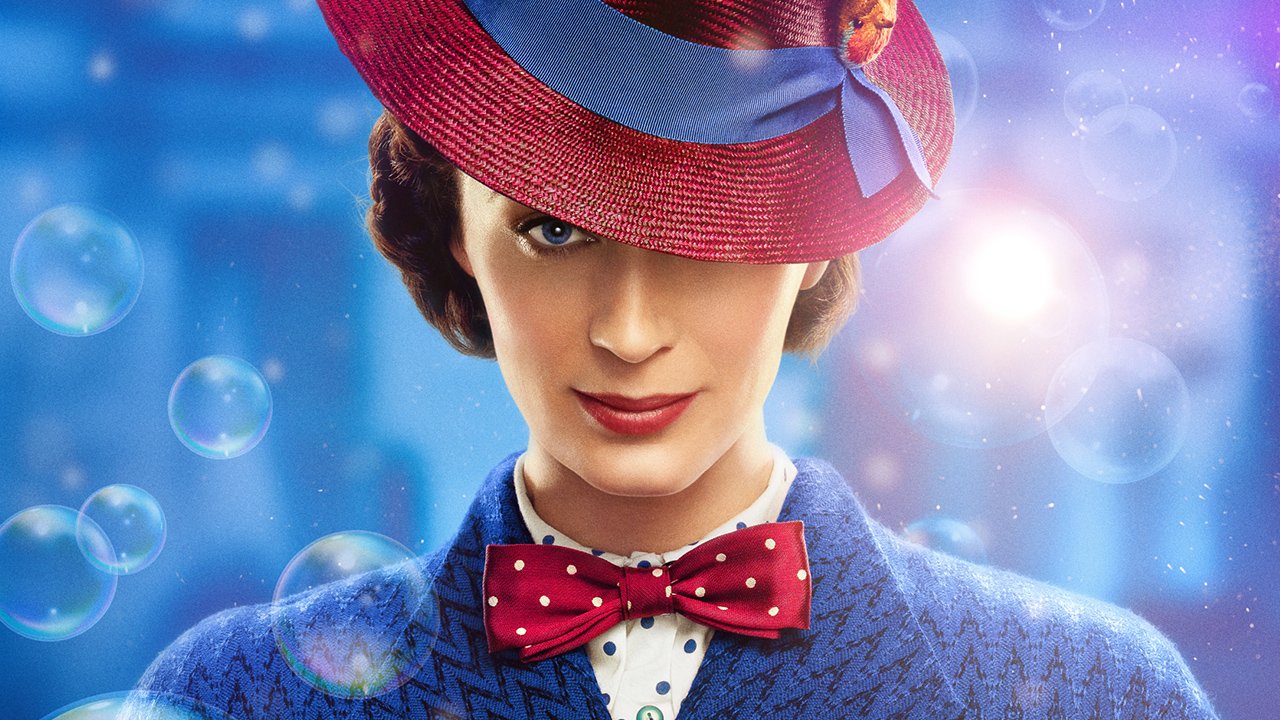The original Mary Poppins movie is considered by many to be Walt Disney’s best live-action achievement during his lifetime. Not only was that movie the only Disney movie that was nominated for Best Picture while Walt Disney was alive, but it’s also become one of the studio’s most enduring and beloved masterpieces. This is quite interesting when one considers the heavy friction that Disney ran into when trying to develop the movie from the original Mary Poppins books, written by P.L. Travers, who was infamously protective of her work, and infamously difficult to collaborate with. There was definitely a lot working against the success of Mary Poppins back in the day, to the point where Disney themselves even made another movie about the Mary Poppins movie’s troubled development period, that being 2013’s Saving Mr. Banks.
Travers disapproved so much of the celebrated Mary Poppins movie that Disney ended up delivering in fact, that Disney even initially banned her from its premiere! The two parties then refused to ever work together again, with Travers also refusing to allow Disney to adapt any of the several Mary Poppins sequel books that she’d already published by that point! Thus, this potent friction between Travers and Disney is why a sequel to Mary Poppins was never made after the original movie’s release in 1964, despite the huge critical and commercial success of that first adaptation, Travers’ disapproval be damned. Travers has been dead for just over two decades now however, and this seems to have been enough time for the studio to work up its nerve to revisit one of its most beloved properties, which is likely also being done in response to the very lucrative live-action remakes that Disney has been delivering over the past several years.
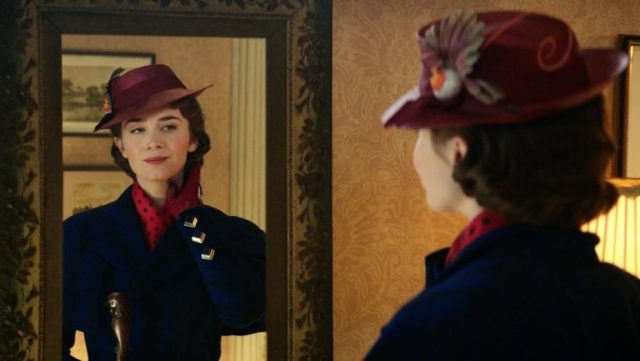
A staggering fifty-four years after the original movie then (that has to be a record!), finally, we have Mary Poppins Returns, a true blue sequel to the original Mary Poppins, with a new cast, a new storyline, and no P.L. Travers to create any headaches for Disney during the production process. It will likely also come as a relief to the original movie’s many fans that Mary Poppins Returns happens to be a pretty strong sequel too, if not a very novel one by today’s standards. Mary Poppins Returns certainly won’t be courting any Best Picture nominations at this year’s Academy Awards, but it feels well-timed for the Holiday season, providing familiar, but very enjoyable family comfort food on the big screen, while also managing to create a legitimately lovable new take on one of Disney’s most enduring icons.
Mary Poppins Returns brings back a few characters from the original, most notably the so-called, “Banks children”, but it’s of course primarily driven forward by its new child protagonists, the offspring of former child lead, Michael Banks. The new children, John, Georgie and Annabel, are given the most attention by the returning Mary Poppins, since Michael is often indisposed, trying to keep a roof over everyone’s head. It’s a little surprising actually that Michael, played here by Ben Whishaw, gets such little screentime in the end, at least compared to his children, which might feel like a missed opportunity for some. Whishaw’s scenes do count for a lot whenever they show up though, and he does perform well, as does Emily Mortimer, who seems a little bit old to be playing the thirtysomething Jane Banks (Mortimer is 47 at this point), but she’s very sweet and likable in the part, and does feel true to the adult version of her former personality.
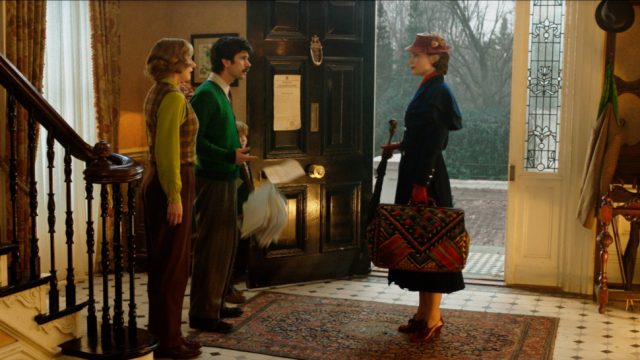
Of course, the most important personality in Mary Poppins Returns is, naturally, Mary Poppins herself. Obviously, former Mary Poppins actress, Julie Andrews can’t reprise her role here, since Mary Poppins is not supposed to have aged in twenty years (let alone the fifty-four real-world years it took to make this sequel!), but the eponymous role is very effectively succeeded by Emily Blunt in Mary Poppins Returns. Blunt does just enough to call back to Andrews’ iconic performance from the original Mary Poppins movie, but she does manage to put her own spin on the magical nanny too, feeling just a little bit more modern and sophisticated when compared to Andrews’ more fluffy and proudly silly take. Still, Blunt rises to the unenviable task of having to succeed Andrews’ Academy Award-winning performance, delivering a charismatic and highly lovable portrayal for the new Mary Poppins, one that I do hope to see again at some point, now that no one is stopping Disney from making more Mary Poppins sequels.
It should also be mentioned that Lin-Manuel Miranda is also a big highlight in Mary Poppins Returns as Jack, a chimney sweep that is essentially meant to serve as a surrogate replacement for one of Dick Van Dyke’s characters from the original Mary Poppins movie. Van Dyke is also the only actor from the original Mary Poppins movie that makes an appearance in Mary Poppins Returns, albeit in a cameo as a completely different character this time, and one that more closely ties in with Colin Firth’s character, William Wilkins. Wilkins happens to be the new president of Fidelity Fiduciary Bank, the same bank that George Banks worked for in the original Mary Poppins movie, as well as the bank that is trying to repossess the Banks home in Mary Poppins Returns. Firth is a bit of an unusual choice for the main antagonist of Mary Poppins Returns, but he does his best to play an outwardly likable, yet inwardly snooty bank president, one that hits a little close to home when it comes to referencing modern capitalism. In the end, Firth’s not bad, even if he’s certainly far from truly menacing!

It’s Blunt and Miranda that have by far the best dynamic in Mary Poppins Returns however, even if the child actors portraying the new Banks children also manage to impress. It’s a little bit strange to suddenly retcon Van Dyke’s original odd job-laden ally to Mary Poppins as suddenly having a ‘secret apprentice’ that the first movie didn’t really touch on, but it’s hard to complain when Miranda manages to be just as jovial and delightful in this sequel as Blunt is. Like Van Dyke’s original inspiration, Miranda’s Jack seems to be the only character who is fully aware of Mary Poppins’ magical abilities, and seems to have a lengthy off-screen connection to her. Mary Poppins Returns isn’t exactly being clever when it comes to Jack so obviously being meant to replace the role that Van Dyke played in the original Mary Poppins movie, which is one of the biggest indicators among the cast that Mary Poppins Returns is sometimes too afraid to truly stand apart from its 1964 predecessor, but I suppose it’s also true that someone needs to vouch for Mary Poppins when Michael and Jane frequently aren’t around, so, fair enough.
Mary Poppins Returns incorporates a few story elements from the successive Mary Poppins books written by P.L. Travers, but for the most part, it tells a completely original story that merely serves as a belated sequel to the original Mary Poppins movie. This sequel remains a period piece, taking place about twenty years after the events of the original Mary Poppins movie, which places it in approximately Great Depression-era 1930. The story thus picks up with Michael and Jane Banks, the child protagonists of the original Mary Poppins movie, who are now adults, with Michael now living in the old family house from the first movie. Michael’s wife passed away off-screen around a year ago, leaving Michael in charge of his three children, John, Georgie and Annabel, whom he attempts to raise with the help of both Jane and his housekeeper, Ellen, one of the handful of returning characters from the first movie, albeit now played by a different actress, and without the presence of family cook, Mrs. Brill this time.

The main obstacle in Mary Poppins Returns comes by way of the bank that Michael’s father, George used to work for while he was alive (apparently, George Banks also passed away off-screen), attempting to repossess the Banks family home, due to an unpaid loan. With Michael only having five days to come up with the money, Mary Poppins thus returns to the family house by way of a repaired kite (one of several nods to P.L. Travers’ Mary Poppins sequel books), in order to look after Michael and Jane, and particularly Michael’s three children. It’s a solid story device that manages to bring Mary Poppins and the Banks clan to a new setting, fueled by a new conflict. This is no doubt also preferable to trying to modernize the story and place it in present day, despite Mary Poppins being seemingly immortal and never aging.
Despite the clear efforts to bring Mary Poppins Returns to a few interesting new places in the early 1930’s though, one of the major sticking points in this sequel is that it sometimes calls back to the original Mary Poppins movie with its storytelling far too much. Several story obstacles and musical backdrops are essentially ripped verbatim from the original Mary Poppins movie, even being presented in the same order, without any real variation. This is likely an intentional choice, since Disney also pulled something similar with 2015’s otherwise superb Star Wars: The Force Awakens, another movie that purported to be a sequel, despite clearly rehashing a ton of story elements from the original. Just like with Star Wars: The Force Awakens, the liberally recycled story elements aren’t nearly enough to deflate the frequent heart and charm throughout Mary Poppins Returns, but the excessive callbacks are nonetheless distracting, and might leave some viewers disappointed that this sequel didn’t ultimately take more risks.
Rob Marshall directs Mary Poppins Returns, a pretty smart choice overall, since Marshall has plenty of experience directing musical productions, and has years of established working history with Disney under his belt. Marshall already delivered a pretty great fantasy musical for Disney just a few years ago with 2014’s Into the Woods, and he’s similarly successful with Mary Poppins Returns, creating a movie that feels like it’s almost a lifelike stage production, while at the same time one that achieves visual feats that could only truly be possible in a movie. It’s no small feat to create direction that feels like it compares in any way to the timeless original Mary Poppins movie, but Marshall actually manages to do the job, skillfully avoiding the feeling of this sequel being half-a-century overdue!
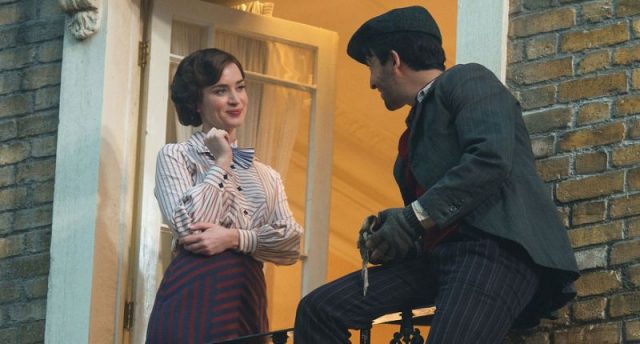
Marshall certainly excels most during the musical numbers, which are often the most lovable and energetic moments throughout Mary Poppins Returns, likely to the surprise of no one, but he also manages to direct the quieter moments very skillfully too. Much of Mary Poppins Returns has a playful and child-like tone, but it also incorporates some sobering elements of Great Depression-era realism too, especially when one of the core conflicts involves the Banks family facing an eviction from their home! Marshall even manages to nicely leverage the deeply-ingrained nostalgia from the first movie in both the dialogue and the delivery from the actors, cleverly acknowledging that the child-like magic of youth is something that often slips away from us as adults, even if it can always be found again. The sense of hope is never fully lost even during the darker moments though, making Mary Poppins Returns a feel-good flick that functions all the better when it unfolds during an especially difficult era of 20th Century history.
As with the original Mary Poppins movie, Mary Poppins Returns is a musical, and one that places quite a lot of emphasis on several original songs that are performed by the cast. The soundtrack is composed by Marc Shaiman, a very experienced composer who seems to work more frequently in television, but does have some musical experience on the big screen. Shaiman does seem to fit well with Mary Poppins Returns as well, composing a score that feels undeniably nostalgic, but one that also doesn’t make a habit of rehashing the songs from the original. That’s good, since many of the original Mary Poppins’ songs are so ingrained in the popular consciousness that it would feel awkward to forcibly re-perform them in a sequel. There are a few classic Mary Poppins song lyrics quoted and referenced in the new songs of Mary Poppins Returns, but thankfully, that’s the worst of it.
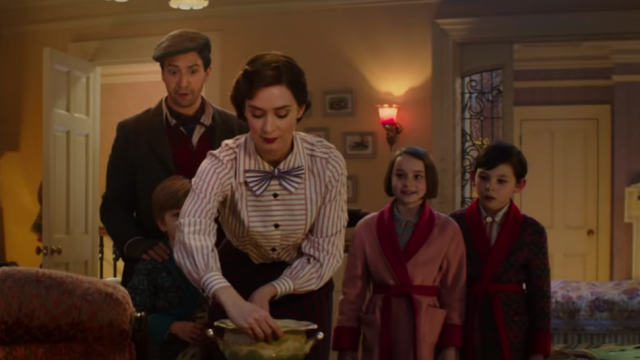
The actual musical numbers are co-written by Shaiman and a Broadway lyricist, Scott Wittman, which does help to give them a sense of authentic stage-like production value. The new songs don’t manage to be quite so iconic or memorable as old favourites from the original Mary Poppins such as, “A Spoonful of Sugar”, “Supercalifragilisticexpialodocious”, or, “Chim Chim Cher-ee”, but there are quite a few great ones. I don’t want to go over the music in Mary Poppins Returns in detail, since it really should be experienced by audiences first-hand on the big screen, but I will say the music is very catchy, well-composed, and consistently accompanied by riveting, eye-popping imagery, whether hand-drawn in animation, or realized in live-action. It’s not on the same level as the original, but the music in Mary Poppins Returns is definitely comparable, and should provide a soundtrack that many Disney fans will be eager to own.
Mary Poppins Returns boasts a nostalgia-flavoured visual suite that makes the rare decision to call back to Disney’s past, rather than trying to take the past and update it, like many of the studio’s recent live-action remakes have attempted to do. This is no doubt partially because Mary Poppins Returns is a period piece that takes place in 1930, but likely also because it’s tough to improve on the look of the original Mary Poppins. Even having originally released in 1964, the original Mary Poppins’ visual design has held up pretty much flawlessly, and it really doesn’t need an update. Mary Poppins Returns wisely understands this, creating a sequel with the same sense of throwback innocence, particularly during the hand-drawn animation sequences, with that style thankfully preserved here, and not needlessly updated to a more modern CG look.
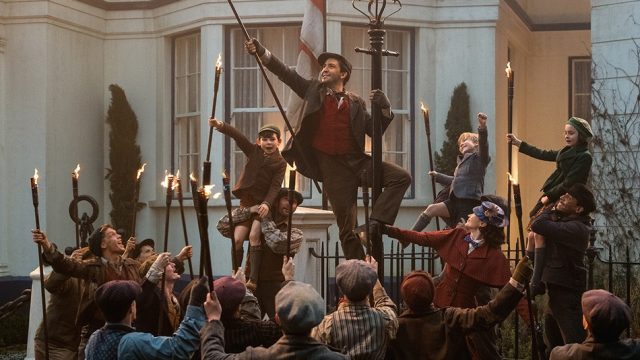
Again, it’s tough to talk much about the animation highlights throughout these hand-drawn sequences without giving away some really awesome surprises, so I’ll just say that the visual direction throughout Mary Poppins Returns is pretty fantastic! The entire movie is staged beautifully, and while lots of that also comes down to Rob Marshall’s inspired direction, it’s also a testament to the visual effects department, who add just the right dash of silly magic to the production, like that metaphorical spoonful of sugar that feels just as tasty in 2018 as it did in 1964! It’s even more impressive that Mary Poppins Returns didn’t ultimately require a 3D or IMAX presentation to really accentuate the visuals either. The only option is a standard 2D digital screening, and that’s really all this movie needs, since the eponymous character’s magic touch effortlessly leaps off of the screen, nicely blurring the lines between reality and fantasy, just as the original movie so effectively did.
Mary Poppins Returns is quite content to be nostalgic comfort food, sometimes to a fault. On the one hand, the fact that the movie copies the original’s personalities and key set pieces so closely means that seeing the original Mary Poppins is really not necessary to enjoy Mary Poppins Returns. That’s especially good for children as well, who are far less likely to have seen the original movie than adults. That said however, if you were expecting a major reinvention of the Mary Poppins formula in Mary Poppins Returns, then you’re going to be disappointed. Mary Poppins Returns instead sticks pretty closely to the 1964 original’s playbook, even with its new story premise. Apparently, the more things change for the Banks family, the more they stay the same.
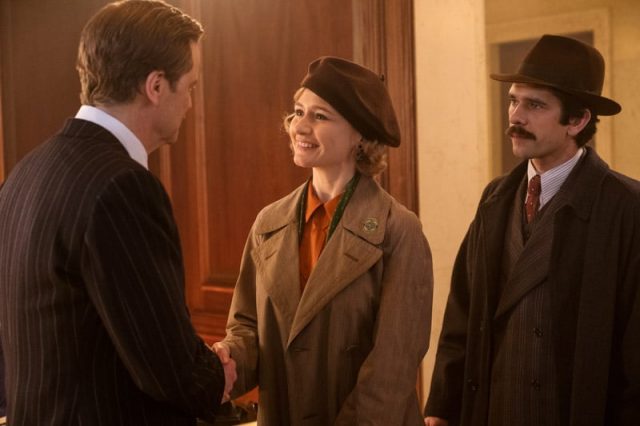
That’s not to say however that Mary Poppins Returns is a disappointment. Even if it does feel like a missed opportunity when it comes to truly elevating what the original Mary Poppins movie achieved over fifty years ago, this sequel is still immensely entertaining, beautifully staged and performed, and chock full of lovable personality and style throughout. This Holiday season is certainly delivering its share of more ambitious and impressive blockbusters on the big screen (hell, even Disney themselves are offering the more forward-thinking Ralph Breaks the Internet for family audiences during the busy Christmas weeks!), but Mary Poppins Returns is a solid choice for anyone who just wants to kick back and enjoy something warm, affectionate and familiar. This sequel is perhaps not all it could have been, but it’s nonetheless wonderful to see that the magic of Mary Poppins hasn’t dulled in the slightest, even after the heinously long wait for its return!

